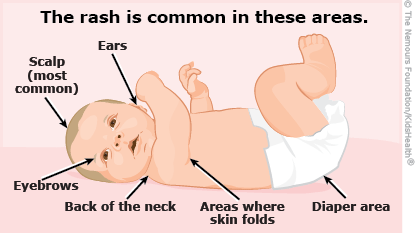Caring for Your Baby's Cradle Cap
Cradle cap is a common condition that affects many babies. It is characterized by scaly, crusty patches on the scalp that can be unsightly and itchy. If your little one is suffering from cradle cap, don't worry - it's not harmful, and there are plenty of things you can do to help clear it up.
What Is Cradle Cap?
Cradle cap is a form of seborrheic dermatitis that affects babies. It usually appears on the scalp, but can also affect other areas of the body, such as the face and neck. The exact cause of cradle cap is unknown, but it is believed to be related to overactive oil glands in the skin, as well as a yeast that can grow in the oils.
Symptoms of cradle cap include scaly, crusty patches on the scalp that may be yellow, white, or brown. The patches may be accompanied by redness and itching, and can be quite noticeable on your baby's head.
What Are the Signs & Symptoms of Cradle Cap (Seborrheic Dermatitis)?
Babies can develop seborrheic dermatitis when they're between 2 weeks and 12 months old. It usually starts with cradle cap. A baby with cradle cap will have slightly red scaly or crusty yellow patches on the scalp. It may also start on the face or diaper area and spread to other parts of the body.
Seborrhea looks:
- red and moist in skin creases and folds (like the neck and behind the ears)
- yellowish with greasy patches or crusts
- scaly or flaky

Seborrheic dermatitis might look uncomfortable or irritating to the skin. But it usually isn't itchy and doesn't seem to bother infants.
What Causes Cradle Cap (Seborrheic Dermatitis)?
The exact cause of cradle cap isn't known. It's likely due to a combination of things. Too much skin oil (sebum) in the oil glands and hair follicles and a type of yeast found on the skin called Malassezia may play roles in the development of seborrheic dermatitis.
How Is Cradle Cap (Seborrheic Dermatitis) Diagnosed?
Health care professionals can diagnose cradle cap and seborrheic dermatitis by the way the skin looks and where the rash is. Babies with seborrheic dermatitis are usually well and the condition should get better on its own or with treatment.
How to Treat Cradle Cap
While cradle cap can be unsightly, it is not harmful and usually clears up on its own within a few months. However, there are things you can do to help manage the condition and make your baby more comfortable.
-
Gently wash your baby's scalp: Use a gentle baby shampoo to wash your baby's scalp every few days. Gently massage the shampoo into your baby's scalp with your fingers, being careful not to rub too hard or scratch the skin.
-
Brush your baby's scalp: Use a soft-bristled baby brush to gently brush your baby's scalp. This can help remove any loose flakes of skin and stimulate the oil glands in the skin.
-
Apply oil or petroleum jelly: You can apply a small amount of mineral oil or petroleum jelly to your baby's scalp to help loosen and soften the scales. Just be sure to wash it out with shampoo at the next bath.
-
Try an over-the-counter product: If your baby's cradle cap is particularly severe, you may want to try an over-the-counter product designed to treat the condition. Look for a product that contains salicylic acid or coal tar, which can help exfoliate the skin and reduce scaling.
What Else Should I Know?
Sometimes seborrheic dermatitis in the diaper area or skin folds can get infected. Talk to your doctor if the rash gets worse or there are any signs of infection (the skin looks red, starts to drain fluid, or feels warm). Cradle cap and seborrheic dermatitis in infants usually get better by 12 months of age. Seborrhea may come back around puberty as dandruff.
When to Call the Doctor
While cradle cap is usually not a cause for concern, there are some cases where you should consult your baby's doctor. Contact your baby's doctor if:
- The cradle cap spreads to other parts of the body
- The patches become infected
- Your baby seems to be in pain or discomfort
- The cradle cap is not improving after a few weeks of treatment
With a little patience and care, you can help clear up your baby's cradle cap and make them more comfortable in the process. Just remember to be gentle when washing and brushing your baby's scalp, and always consult your doctor if you have any concerns.









